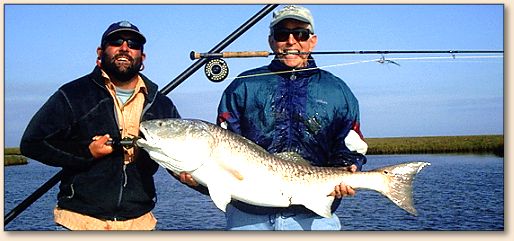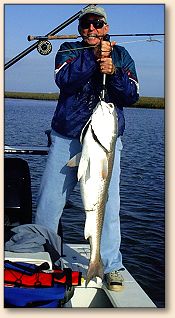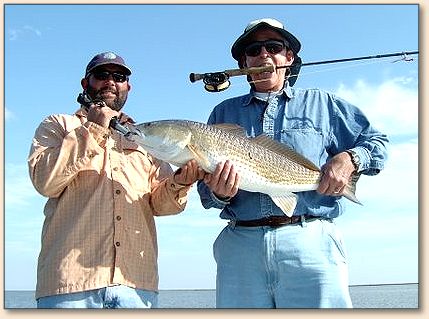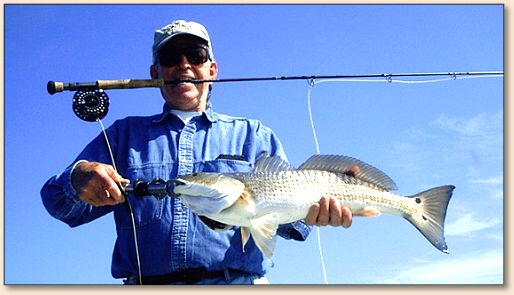I have just been blessed with another new fishing
adventure south of New Orleans. If you are a
flyfisherman that loves redfish, this is a must
trip. The whole event is a worthwhile experience.
And to think of it, it is only 4 hours away from Florida!
Gary, Bill, Tony and I left on Sunday afternoon.
It was still light when we passed through the heart
of New Orleans. The Katrina devastation was so tragic.
Even though we all have seen pictures and read about
the damage, you really can't get the impact of it
until you see for yourself. Mother Nature did a number.
I have no concept of what it will look like 10, 15 years
from now. We stayed at a Holiday Inn type motel and most
of the guests were Katrina workers. They started at 4:30
am at the continental breakfast getting ready for work.
A typical day for us was to leave the motel at 5:30 or
6 am. It was a 25 min trip for us to meet the guides.
We launched at Port Sulfur about 7 or a little after.
The first fishing spots were 20 to 25 minutes from the
launch. In the two days we were on the water, I only
saw one other fishing boat. Even our two boats didn't
see each other after we left the dock. The earliest day
we returned to launch was 4:45 pm and couple of times it
was dark with the boat lights on. The boats were first
class flats boats. One a Dolphin and the other a Hellsbay.
Both had elevated casting "stools" and perfect fly fishing
boats. We rigged our rods at the motel and were ready to
fish when the boat stopped. Everyone rigged 8 wt's and
some over lined with 9 wt lines for short fast casts.
A couple of guys had spinning rods for occasional blind
casting from the middle of the boat.
Tony Angelino was my partner for the trip. I got up first.
Fishing was slow for a short while due to a cloudy sunrise.
As you know there are two things that make sight fishing
tough and that is lack of light and windy water. We had
both to start with. However, it wasn't long before we saw
our first fish. We were poling along a grass marsh on my
left maybe 25 feet off when we came to a little point jutting
out. As we got a little closer at 11 o'clock/30 feet was our
first red. Since he was moving straight at me I couldn't tell
much about him. A 30 foot cast on his nose with the terminator
crab fly did the job. He sucked it in, a hard strip set, and
he was on. He turned to my right showing a huge tail and wake
and the slug fest began. Once he started right we could see
his length. He was big one. As Brian, the guide said, it was
"a donkey." Surprisingly he didn't go very far into the backing,
just slugging it out with me, back and forth, side to side.
I don't know how long it took me but we finally got him close
enough to know that we had a big one. Brian had a big net and
the donkey filled it with the tail sticking out. My first
redfish of the day and the trip was 43 in. and 32 lbs! What
a way to start! It was all down hill after that having to
settle for 10 to 15 pounders.

Tony and I alternated on the casting deck and we both
started catching reds as the sky cleared and the wind
died down. On one occasion Tony had a fish on and I
was sitting on the cooler seat in the middle of the
boat. Brian very calmly and slowly said, "Tom, I
want you to get up slowly and quietly. Get your rod
and be ready to cast off the right side. Be quiet and
slow. " His calmness made me do just that. Then he
instructed " I want you to make a cast 20 feet to where
I am pointing. Don't worry about hitting me, do just
that." I made an overhead cast to where he was pointing,
the line straightened, and the terminator was eaten. The
fight was on. Tony and I had a double. Tonys was a very
good fish and mine was a 32 in. 14 Lb beauty. And we were
just getting started!

About 11 am, Brian said "Let's switch to poppers." I wasn't
too sure about that as we were regularly banging reds. But
we did. I tied on a yellow balsa popper that Gene Andre taught
us in fly tying. Nothing special, just a good casting popper
on a #1 hook. Tony tied on a "catamaran" that he had just
learned. They were both effective. It was still sight
fishing with mostly 25 to 45 ft casts. We just weren't
able to see them much further out.
It was a blast. You put a fly on their nose - they were
not spooky - just hungry. Since they were that close and
the water relatively clear it was easy to see them attack
the fly.
It is difficult for a red to take a popper. They approach
the fly straight on, not turning their body sideways, but
raising their head. In that position their eyes cannot see
the bait/fly and must rely on sound and water movement for
direction. The technique was to use short strong strips for
the pop, moving water then pause. More often than not, they
would not get it the first time. You just kept up that
technique until he was able to get it in his mouth. Several
times you would have the popper pretty close to the boat and
the red would keep trying. And these were not small fish -
8 to 10# reds!
One time I worked a red to the side of the boat and he
still hadn't given up on eating the popper. I literally
used the rod like a cane pole, moving the fly back and
forth right beside the boat before he was able to eat it.
Can you imagine a 27 in. redfish concentrating on a meal
so hard that he didn't pay any attention to the boat,
the rod and line, or me 9 feet away?
Tony was having just as much success with his catamaran
as I was with the balsa popper. Brian really liked Tony's
"cat".
We kept "popping" till mid afternoon and then switched
back to terminators. We returned to the dock about 4:45.
We lost count at 13 reds but I'm sure there were a few
more. The smallest was perhaps 25 in., most were 9 to
14 lbs, with the one 32 pounder.
Day two we switched boats and guides with Bill and Gary.
We met our guide, Rich Waldner, at his home which was
near the launch. We were on the water at 7:15 headed
southwest toward the Gulf. It was cloudy again and a
stronger wind than yesterday. At one point we were 100
yards from the Gulf with a dune between us and the open
water.
It took awhile for us to hook up due to the lack of sun
and windy water. One of the first fish we saw was at least
200 feet away. We could see a fin, tail and back out of
the water about 6 ft off the shore. Rich thought it might
be a gar but as we got closer we could see the huge bronze
back. Tony was up and put a few casts on him but he finally
spooked and moved away. We got a closer look as he passed
by off to our right. We got a good look at a 50 inch plus
redfish! What a sight. If Tony had hooked up he might still
be there trying to get him in.
This was a much tougher fishing day. The sun finally came
out but we had to deal with a 10 to 20 mile wind off the
Gulf. Our fishing was limited to the lee side of the marshes
and in sheltered "ponds." We managed over twenty fish
including two doubles and a triple. When one made a hook
up Rich made him move off the platform and the other person
looked for a second fish. As a redfisherman you know there
are often more than one.

One time I was on the "stool" and hooked a nice red about
40 feet out. Tony took my place while I worked my hookup.
Then he hooked up. Tony's fish came close enough for us
to see a third red almost glued to the side of his fish.
Rich had me put full pressure on mine and get it in quickly.
After getting mine in the landing net and Rich freeing the
fly I went after the third red. With Tony's fish moving
left to right about 20 feet away we saw the outside fish
still glued to Tony's fish. I put the terminator just over
the back of the Tony's fish and the third red ate it. We
called that a triple. Rich will have this pic on his web
site (www.fishwithrich.com) soon.
We stayed until 4:45 before heading back. About 30
minutes before, with the sun low, wind up, we spooked
more fish than we were able to cast to. We just couldn't
see and I was casting off to the right, which is not my
strength. We gave up and as Rich was poling out of an
oyster bed I made a few false casts (to my right). A
red hit it and ran under the boat, across the oyster
shells and I lost my first and only fly of the trip.
The leader was shredded and was a curly stub.
About the type of fishing, it was all sight fishing,
in shallow water, usually working near the marsh
grass banks. The boats do not have trolling motors
and the guide must pole in very shallow areas. Also,
there are times when you must be quiet particularly
when the visibility is low as you will run up on a
fish before you know it.
Most fish are caught within 20 to 40 feet of the boat.
Just like bonefishing you need to get off a fairly
quick cast as many of the fish are moving, just not as
fast as bones. Some of the fish are moving parallel to
the bank and you can get more than one shot. Then
other times they will spook on the first cast. The fly
must be right on their nose or very close for them to
see it. Seldom do they turn on the fly. I had one
exception with a fish right next to the grass moving
slowly to my right. I launched about a 25 foot cast,
perfect distance but I hit him on or near his tail,
he spun around and took the terminator! He was hungry!

Rich Walden calls it "close combat" fishing (Rich is an
ex marine). I caught maybe one or two fish over 40 feet
away. Most were between 20 and 40. You must put the fly
on their nose. I used a 4 foot furled leader with an 18"
/20lb tippet. Casting in all directions with accuracy.
Rich feels that a stiff 40lb leader turns the fly over
better on short casts. I tried it and I think he maybe
right. Although I didn't have a 9 wt line with me, the
uplining should work to load the rod quicker on short casts.
The guides and their equipment are first class. You have
had guides that look on a days fishing as work, their job.
Rich and Brian love what they do. They are enthusiastic
and passionate about the whole experience and really want
you to have a memorable time.
Thanks to Scud, Hugh and Bill for paving the way for us
over there. Again, if you love fly fishing and a passion
for redfish like I do, you must experience this. God
willing, I will go again.
PS. I can give a testimonial for rotator cuff surgery. It really went well.
~ Tom Barnes
November 2006
|







